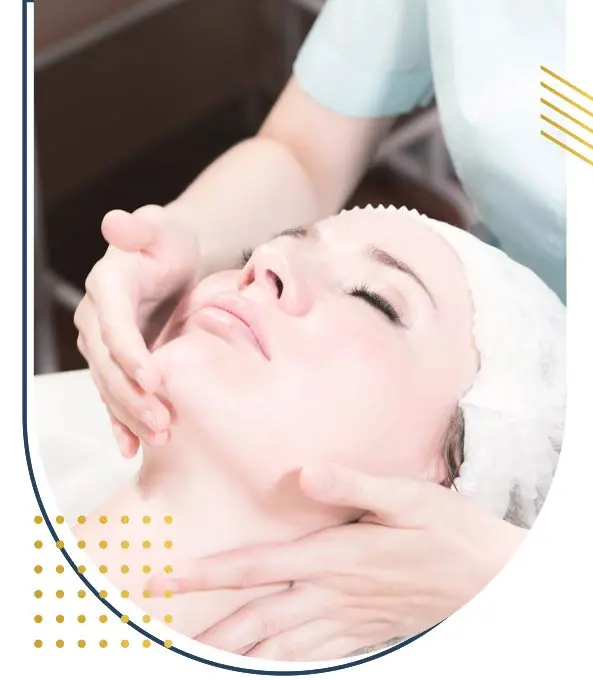
With time and the aging process of the face, the skin loses its elasticity. As a result, the facial tissues become slack and this leads to skin sagging especially on the jawline, in the neck and in the folds between the nose and the corners of the mouth.
But, fortunately, it is possible to treat these imperfections thanks to plastic surgery.
Facelift realized in Egypt is a plastic intervention that aims at eliminating aging signs and rejuvenating facial features by eliminating wrinkles, treating and removing sagging skin on the face for a more youthful appearance.
This procedure does not only improve facial appearance, but also allows the patient to regain self confidence and feel young.
Facelift price in Egypt
The price facelift Egypt is avantageous, you can ask for your free online quote quote by filling in the quotation request form on our website or contact us by phone and we will give you the cost facelift Egypt and answer all your questions.
What are the types of the Facelift procedure ?
Traditional Facelift (SMAS Facelift) :
Ah, the classic, the timeless, the traditional facelift! This procedure, also known as the SMAS (Superficial Musculo-Aponeurotic System) facelift, is a tried-and-true method that has been refined over the years.
The SMAS is a layer of tissue located beneath the skin that is targeted during this procedure to lift and reposition sagging facial tissues. Surgeons make discreet incisions usually along the hairline or behind the ears to access the underlying structures.
The skin is then lifted, excess fat may be removed or redistributed, and muscles and tissues are tightened.
This comprehensive approach addresses not only skin laxity but also deeper structural issues, resulting in a more rejuvenated and natural-looking appearance. Recovery time varies but generally takes several weeks, during which swelling and bruising gradually subside to reveal the refreshed visage beneath.

Mini Facelift (S-Lift) :
For those seeking a less invasive option or targeting specific areas of concern, the mini facelift, also known as the S-Lift due to the shape of the incision, offers a more subtle yet effective solution.
This procedure focuses on the lower half of the face, particularly the jawline and jowls, with smaller incisions and a shorter recovery period compared to its traditional counterpart.
The incisions are typically shorter and located around the ears or along the hairline, allowing for less scarring and a quicker healing process.
Through these incisions, the surgeon tightens underlying tissues and removes excess skin, resulting in a firmer, more youthful appearance. The mini facelift is ideal for individuals with mild to moderate signs of aging who desire a more refreshed look without the downtime associated with more extensive procedures.
Mid Facelift :
Ah, the mid facelift, often referred to as the "cheek lift," where the focus is on rejuvenating the middle portion of the face, including the cheeks and under-eye area.
As we age, the midface tends to lose volume and descend, leading to hollowed cheeks and deepening of nasolabial folds.
The mid facelift addresses these concerns by lifting and repositioning the underlying tissues, restoring youthful contours and improving overall facial harmony.
During the procedure, incisions are typically made along the hairline or inside the mouth to access the underlying structures.
By lifting the cheeks and tightening the surrounding tissues, the mid facelift can create a more youthful and rejuvenated appearance. Recovery time varies but generally ranges from a few weeks to a month, during which swelling and bruising gradually subside to reveal the beautifully lifted midface.
Thread Lift :
Ah, the thread lift, a modern marvel in the world of facial rejuvenation! Unlike traditional facelift techniques that involve surgical incisions, the thread lift offers a minimally invasive alternative using dissolvable sutures with small barbs or cones attached.
These threads are inserted under the skin using a fine needle and then gently pulled to lift and reposition sagging facial tissues.
The threads provide immediate lift and stimulate collagen production over time, resulting in gradual improvements in skin laxity and texture.
While the thread lift offers a quicker recovery time and less scarring compared to traditional facelifts, the results may not be as long-lasting and may require touch-up treatments to maintain optimal results. Nonetheless, for those seeking a subtle yet noticeable lift without the downtime of surgery, the thread lift can be a fantastic option.
Deep Plane Facelift :
Ah, the deep plane facelift, the gold standard for addressing severe facial aging and laxity! This advanced surgical technique involves lifting and repositioning not only the skin but also the deeper facial tissues, including the SMAS and facial muscles.
By accessing these deeper layers, the surgeon can achieve more comprehensive and long-lasting results compared to traditional facelift techniques. The incisions are typically similar to those used in traditional facelifts but with a deeper dissection to access the underlying structures.
Through meticulous manipulation and repositioning of the tissues, the deep plane facelift can address sagging jowls, deep nasolabial folds, and laxity in the neck area, resulting in a dramatically rejuvenated appearance. While the recovery time may be longer compared to less invasive procedures, the results are often worth the investment, with many patients enjoying a refreshed and youthful appearance for years to come.
Composite Facelift :
Ah, the composite facelift, a comprehensive approach to facial rejuvenation that combines the benefits of traditional facelift techniques with additional procedures to address multiple signs of aging simultaneously.
This advanced technique involves lifting and repositioning both the skin and deeper facial tissues, as well as addressing volume loss with fat grafting or dermal fillers.
By combining various modalities, the composite facelift can achieve more natural and harmonious results, restoring youthful contours and improving overall facial balance. Surgeons may also incorporate additional procedures such as blepharoplasty (eyelid surgery) or brow lift to further enhance the results.
While the composite facelift may require a longer recovery time compared to individual procedures performed separately, many patients find the comprehensive approach worth the investment for the transformative results it offers.
Why opting for a facelift Egypt ?
The objective of a facelift surgery Egypt is to lift and reposition facial features that have sagged over time.
It is also to restore volume where the relief has become hollow and to give harmony to the face so as to look younger. Then, the face and neck regain the appearance they had a few years earlier.
This intervention is performed on both women and men from the age of 40.
It is sometimes performed earlier when the imperfections are constitutional (hereditary factors) and not related to age such as certain early frown lines due to muscle hyperactivity.
There is no age limit, only contraindications related to health can prevent this surgery, that is why you must consult your surgeon to examine you, evaluate your health and give you blood analysis to do before the operation so as to be sure you can undergo it without any problems.
The recommendations before Facelift surgery
- It is recommended to stop smoking at least one month before and after the surgery in order not to interrupt the healing process.
- It is forbidden to take aspirin during the 10 days before your facelift surgery.
- Hair must be washed the day before the intervention.
- It is recommended not to eat or drink 8 hours before the operation.
Additional preparation.
Consultation with a Plastic Surgeon :
Before anything else, schedule a consultation with a board-certified plastic surgeon who specializes in facelift procedures.
During this initial meeting, you'll discuss your aesthetic goals, medical history, any medications you're taking, and any previous surgeries you've undergone.
Your surgeon will evaluate your facial anatomy, skin quality, and overall health to determine if you're a suitable candidate for a facelift and which specific technique would best address your concerns.
Medical Evaluation :
As part of the preoperative assessment, your surgeon may request various medical tests, such as blood tests, electrocardiogram (ECG), or imaging studies, to ensure you're in good health and fit for surgery.
It's crucial to disclose any preexisting medical conditions, allergies, or medications you're taking, including over-the-counter supplements and herbal remedies, as some may interfere with the surgery or anesthesia.
Discontinuation of Certain Medications :
In the weeks leading up to your facelift, your surgeon may advise you to stop taking certain medications that can increase the risk of bleeding or interfere with anesthesia.
These may include blood thinners, nonsteroidal anti-inflammatory drugs (NSAIDs), aspirin, herbal supplements (such as ginkgo biloba or garlic), and some dietary supplements. Follow your surgeon's instructions carefully and inform them of all medications you're taking to ensure a safe and successful procedure.
Lifestyle Adjustments :
In the days leading up to your facelift, maintain a healthy lifestyle and prioritize self-care. Get adequate rest, eat a balanced diet rich in nutrients, stay hydrated, and avoid excessive alcohol consumption.
Taking care of your physical and mental well-being can help optimize your body's ability to heal and recover from surgery.
Arrangements for Recovery :
Plan ahead for your postoperative care and recovery period. Arrange for someone to drive you home after surgery and stay with you for the first 24 to 48 hours to assist with activities of daily living. Stock up on essential supplies, such as soft foods, ice packs, and prescribed medications, to ensure comfort and convenience during your recovery at home. Follow your surgeon's postoperative instructions closely, including any restrictions on physical activity, skincare, and follow-up appointments.
Final Preparations :
On the day of your facelift, follow any specific preoperative instructions provided by your surgeon, such as fasting from food and water before surgery. Wear comfortable, loose-fitting clothing and avoid wearing makeup, jewelry, or contact lenses. Arrive at the surgical facility on time, and be prepared to undergo preoperative assessments and meet with your surgical team before the procedure.
The different types of facelift
Forehead lift :
Its aims is to eliminate wrinkles of the forehead, enhance and restore lost volume to this part of the face.
Temporal lift :
It acts on the cheeks, improves the nasolabial folds, restores lost volume and is generally associated with cervico facial lift.
Cervico facial lift :
The cervico-facial lift acts on the lower face and neck by eliminating wrinkles and tightening the skin on these facial areas.
How is it performed ?
Facelift Egypt is realized under general anaesthesia and the length of hospitalization is of 2 nights.
It lasts about 2 to 3 hours, it depends on the case of each patient and the degree of the sagging skin to treat.
The operation can be performed in different ways depending on the procedure.
The incision is made around the ear and in the hair so that it is as hidden as possible. The detachment is then made under the skin which extent depends on the degree of sagging tissues.
It starts in the temple, in the hairline or underneath depending on the hair placement, then goes in front of the ear, then in the earlobe, then behind the ear. The areas that are tightened are not necessarily only skin areas, they can be deeper, depending on the case such as the muscle area.
The skin is then naturally tightened, the excess is removed and the stitches are not under tension.
A bandage around the head is generally applied by the surgeon.
Facelift Egypt :aftercare and recovery
- After facelift Egypt, you can experience bruising and swelling that will fade with time.
- The surgeon will prescribe you painkillers to alleviate the pain.
- A feeling of tension in the face persists for a few days.
- You must stay at home and rest while avoiding strenuous activities.
- Scars should not be exposed to the sun for 6 months following the procedure.
- Daily activites can be resumed from the 2nd to the 3rd postoperative week.
- Following your surgeon’s recommendations is necessary.
Facelift Egypt results
Facelift Egypt results are long lasting and excellent, this intervention enhances and rejuvenates facial features without changing them, thus, the patient will regain self confidence by feeling younger than before with a radiant face and without wrinkles.
What are the risks of the face lift procedure ?
Bleeding :
Bleeding is a common risk during and after surgery. While surgeons take precautions to minimize bleeding during the procedure, excessive bleeding can occur, leading to hematoma formation (blood accumulation under the skin).
Hematomas may require surgical drainage to prevent complications such as infection and tissue damage.
Infection :
Infection is a potential risk following any surgical procedure. Despite sterile operating conditions, bacteria can enter the surgical site, leading to infection. Symptoms of infection may include redness, swelling, warmth, tenderness, and fever.
Prompt treatment with antibiotics is essential to prevent the spread of infection and promote healing.
Scarring :
Scarring is an inevitable outcome of surgery, including facelift procedures. While plastic surgeons strive to minimize scarring by placing incisions in discreet locations and using meticulous closure techniques, the extent of scarring can vary from person to person.
Scars may fade over time but may remain visible, especially in individuals with a tendency to form keloids or hypertrophic scars.
Nerve Damage :
Facelift surgery involves manipulation of facial tissues, which can inadvertently damage sensory or motor nerves, leading to temporary or permanent numbness, tingling, or weakness in the face. Most nerve injuries resolve spontaneously within a few weeks to months, but in rare cases, permanent nerve damage may occur, affecting facial sensation or muscle function.
Skin Necrosis :
Skin necrosis, or tissue death, can occur due to inadequate blood supply to the skin following surgery.
Factors such as excessive tension on the skin, compromised blood flow, smoking, or underlying medical conditions can increase the risk of skin necrosis. Prompt intervention may be necessary to remove necrotic tissue and promote wound healing.
Anesthesia Risks :
General anesthesia or sedation administered during facelift surgery carries inherent risks, including adverse reactions, respiratory complications, and cardiovascular events. Your anesthesiologist will monitor you closely throughout the procedure to minimize these risks and ensure your safety.
Hair Loss :
Temporary or permanent hair loss around the incision sites is a potential risk of facelift surgery, particularly in individuals with a predisposition to hair thinning or alopecia. Proper incision placement and closure techniques can help minimize the risk of noticeable hair loss.

Asymmetry :
Despite meticulous surgical technique, asymmetry in facial appearance may occur following facelift surgery. Factors such as variations in tissue healing, swelling, and underlying facial anatomy can contribute to asymmetrical results. Revision surgery may be necessary to correct significant asymmetry and achieve the desired outcome.
Dissatisfaction with Results :
While many patients are satisfied with the results of their facelift surgery, there is a risk of dissatisfaction with aesthetic outcomes.
Unrealistic expectations, poor communication with the surgeon, or unforeseen complications may contribute to dissatisfaction. It's essential to have realistic expectations and maintain open communication with your surgeon throughout the surgical process.
Delayed Healing and Prolonged Recovery :
Facelift surgery involves tissue manipulation and surgical trauma, which can lead to delayed wound healing and prolonged recovery.
Factors such as age, overall health, lifestyle habits, and adherence to postoperative instructions can influence the speed and quality of recovery. Patience and diligent adherence to postoperative care guidelines are essential for optimal healing and long-term results.

